Background: This is a new home and we are making improvements almost daily. My ground is very rocky with rock sizes from gravel size to well exceeding a thousand pounds, plus hard clay. Digging in any capacity manually with a shovel is not possible except in areas of fill.
The wife has started some fruit trees and blueberry bushes (holes dug with a FEL and stump bucket) which the deer seem to like a lot. So now I am putting up a 6' high fence in my back yard to help protect the garden. Probably with a wire at the seven foot level as the posts are long enough. Yes I know 8' is a much better deer fence but 6' is what I am doing and will make other allowances as required. Hopefully this will keep predators away from the cats and chickens to be. I know I will have to add horizontal fencing at the ground level to keep predators from digging under, etc. But this story is about the TSC County Line post hole digger.
The corner posts, end posts and gate posts are 6 x 6 square, with 4 x 4 support posts on either side, plus 4 x 4 posts horizontal and T-posts as line posts. A farmer friend has a fairly new TSC County Line post hole digger that is made by SpeeCo. We drilled a whole bunch of 12" holes at his place recently using my tractor and everything went wonderfully in his sandy loam soil. However, I never thought his PHD would be able to perform well at my place, but he insisted we try. I really did not want to break his augers, have to replace them and then still purchase heavier equipment after that. In the meantime I had lined up two different heavier duty PHDs to purchase and associated 9" and 12" augers, along with spare parts I was going order one set of Monday (tomorrow) after doing a PHD test at my place with his equipment today and expecting failures.
PHD test: Due to misalignment of the PHD/auger mounting holes, only one of the two bolts can be used. I started the test at the sites I knew would be the worse and the PHD functioned much better than expected. With any PHD I was expecting to use the PHD for a few inches depth and then have to break things up with digging bars and worse case scenario- use the stump bucket. Then clean out the hole with the manual rocky ground post hole digger and then set the tractor PHD back in place and drill a bit more until it couldn't go down any farther, pull it out, dig with the bars, etc. etc. And this is exactly what happened, including using the stump bucket and even moving the hole's location 18" out of line as digging was impossible with what we had in the original post's location. In the end this first 36" deep hole took well over an hour to dig and due to stump bucket use is probably 30" diameter for the first 18" of depth. But the PHD and 12" auger held up well with only one shear bolt broken.
It took us 6 hours to dig nine holes with most of them ~ 36" deep but a couple only 32" due to hard pan we just could not get through. Three of the holes went extremely well with little extraneous digging required and three more with limited manual intervention. So that left three other holes with extreme manual intervention- but mostly completed. Fortunately two days prior we received a day of rain and this is what made our digging easier than I expected.
In the end the TSC PHD held up extremely well and is really not showing much wear on its digging surfaces. I am surprised. And it did so with only one of the two auger mounting bolts attached. However, it was very difficult to remove this bolt as it was bent and had to be driven out with a large punch and three pound sledge hammer.
So I will drill all of the 9" holes for the 4" support posts using this TSC PHD and feel pretty confident it is up to the task.
In the second pic with a closeup of the clay, about 1/3 of that pile are rocks ~ fist size and smaller and a little smaller than football size and covered with wet clay. This was another hour+ long dig with two men working really hard with two digging bars at the same time.
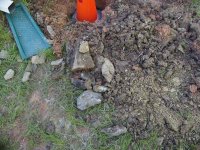
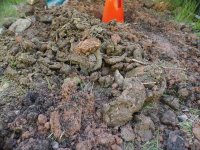
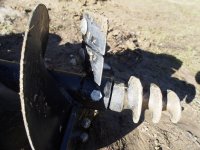

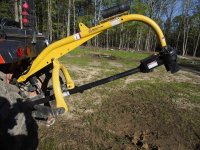
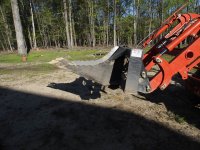
The wife has started some fruit trees and blueberry bushes (holes dug with a FEL and stump bucket) which the deer seem to like a lot. So now I am putting up a 6' high fence in my back yard to help protect the garden. Probably with a wire at the seven foot level as the posts are long enough. Yes I know 8' is a much better deer fence but 6' is what I am doing and will make other allowances as required. Hopefully this will keep predators away from the cats and chickens to be. I know I will have to add horizontal fencing at the ground level to keep predators from digging under, etc. But this story is about the TSC County Line post hole digger.
The corner posts, end posts and gate posts are 6 x 6 square, with 4 x 4 support posts on either side, plus 4 x 4 posts horizontal and T-posts as line posts. A farmer friend has a fairly new TSC County Line post hole digger that is made by SpeeCo. We drilled a whole bunch of 12" holes at his place recently using my tractor and everything went wonderfully in his sandy loam soil. However, I never thought his PHD would be able to perform well at my place, but he insisted we try. I really did not want to break his augers, have to replace them and then still purchase heavier equipment after that. In the meantime I had lined up two different heavier duty PHDs to purchase and associated 9" and 12" augers, along with spare parts I was going order one set of Monday (tomorrow) after doing a PHD test at my place with his equipment today and expecting failures.
PHD test: Due to misalignment of the PHD/auger mounting holes, only one of the two bolts can be used. I started the test at the sites I knew would be the worse and the PHD functioned much better than expected. With any PHD I was expecting to use the PHD for a few inches depth and then have to break things up with digging bars and worse case scenario- use the stump bucket. Then clean out the hole with the manual rocky ground post hole digger and then set the tractor PHD back in place and drill a bit more until it couldn't go down any farther, pull it out, dig with the bars, etc. etc. And this is exactly what happened, including using the stump bucket and even moving the hole's location 18" out of line as digging was impossible with what we had in the original post's location. In the end this first 36" deep hole took well over an hour to dig and due to stump bucket use is probably 30" diameter for the first 18" of depth. But the PHD and 12" auger held up well with only one shear bolt broken.
It took us 6 hours to dig nine holes with most of them ~ 36" deep but a couple only 32" due to hard pan we just could not get through. Three of the holes went extremely well with little extraneous digging required and three more with limited manual intervention. So that left three other holes with extreme manual intervention- but mostly completed. Fortunately two days prior we received a day of rain and this is what made our digging easier than I expected.
In the end the TSC PHD held up extremely well and is really not showing much wear on its digging surfaces. I am surprised. And it did so with only one of the two auger mounting bolts attached. However, it was very difficult to remove this bolt as it was bent and had to be driven out with a large punch and three pound sledge hammer.
So I will drill all of the 9" holes for the 4" support posts using this TSC PHD and feel pretty confident it is up to the task.
In the second pic with a closeup of the clay, about 1/3 of that pile are rocks ~ fist size and smaller and a little smaller than football size and covered with wet clay. This was another hour+ long dig with two men working really hard with two digging bars at the same time.






